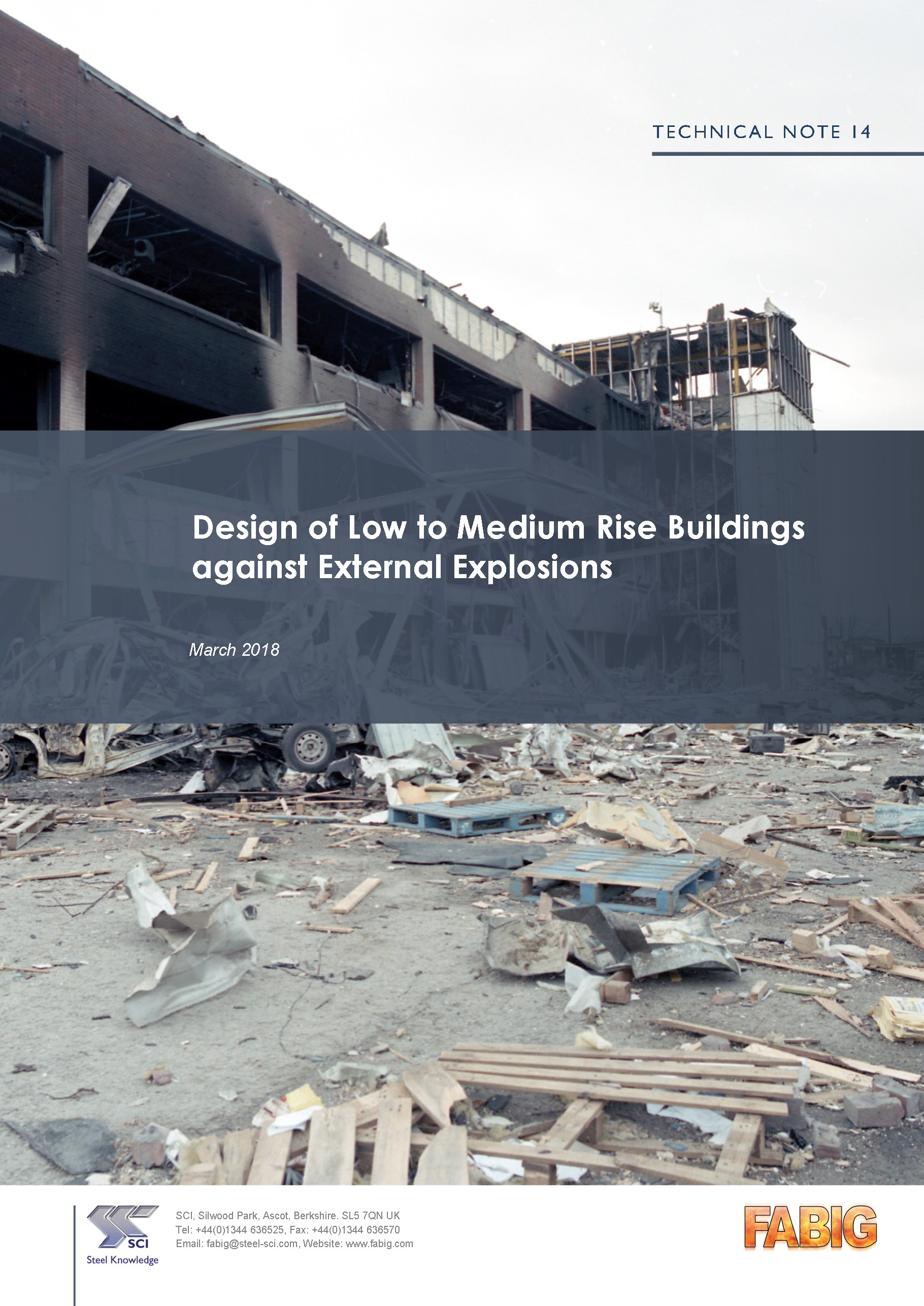Technical Note 14
Design of Low to Medium Rise Buildings against External Explosions

FABIG Members: Log-in to access all FABIG resources LOG IN
SUMMARY
This Technical Note provides recommendations and advice for the structural design of low to medium rise steel-framed buildings (typically two to five storeys high) subjected to blast action due to external explosions. Such action is often associated with industrial accidents and the blast impacts the whole (or large areas) of the building’s elevation. This is distinguished from explosions caused by terrorist attacks or internal accidental explosions where, whilst the damage may be localised, it can nevertheless have a disproportionate effect in the absence of a robust building design.
Low to medium rise steel-framed buildings are commonly used as offices and are often found in the vicinity of industrial sites. They usually derive their resistance to lateral actions from a system of bracing members. Designing a building for explosion resistance requires that the blast overpressures which could result from an explosion be quantified, the blast actions on the building due to these overpressures be calculated, structural performance criteria be set, structural response be calculated and the building structure be verified to resist these actions within the performance criteria.
- Section 2 describes the different types of explosion that can be caused by industrial accidents and the characteristics of blast waves that result from them. Methods of quantifying the blast wave characteristics from typical classes of industrial accidents are briefly described, although site specific studies by safety specialists are often conducted to determine more accurately the blast design scenarios and associated blast waves;
- Section 3 describes the calculation of the blast actions on a structure from a knowledge of the characteristics of the blast wave. It deals with the calculation of the reflected blast wave on the different faces of a building and the resultant blast action on the whole building. It also gives methods for calculating the reflected blast wave internally, for buildings that have openings in their façades;
- Section 4 provides design values of material properties and combinations of actions that should be used in blast resistant design;
- Section 5 deals with the analysis of structures subjected to blast actions. It describes the different structural response regimes to dynamic loads caused by blast action and then focuses on the use of Single Degree of Freedom (SDOF) methods of analysis. Specific reference is made to software that has been developed to perform nonlinear SDOF analysis of steel beams, composite beams and multi-storey building frames;
- Section 6 describes the ultimate strength design criteria in terms of deformation and rotation limits of members, connections and frames. The verification of the structural members and connections follows the procedures of EN 1993. A number of additional requirements are included to ensure that the objectives of dissipating blast energy and ensuring a ductile response are achieved;
- This Technical Note is illustrated by the assessment of a three-storey office building against two explosion scenarios, with different overpressure magnitude and blast wave characteristics. The building is described in Section 7, and sample calculations are presented in the Appendices.
TABLE OF CONTENTS
FOREWORD
CONTENTS
- INTRODUCTION
- Background
- Response of buildings to explosions
- Scope of this Technical Note
- EXPLOSIONS CAUSED BY INDUSTRIAL ACCIDENTS
- Introduction
- Blast wave characteristics
- Blast wave parameters
- ACTIONS ON STRUCTURES DUE TO BLAST
- Shock wave reflection
- Pressure wave reflection
- Blast load interaction with structures
- Effect of openings in structures
- DESIGN VALUES OF MATERIAL PROPERTIES AND ACTIONS
- Material properties
- Actions and combinations of actions
- ANALYSIS OF STRUCTURES SUBJECTED TO BLAST ACTIONS
- Objectives of the analysis
- Response regimes
- Analysis methods for dynamic response
- Single degree of freedom (SDOF) method
- Simplified analysis software
- BASIS OF DESIGN
- Design criteria
- Deformation limits
- Design of structural members
- APPENDIX A BUILDING DESIGN FOR PERMANENT AND VARIABLE ACTIONS
- Permanent and variable actions
- Structural scheme
- APPENDIX B ACCIDENTAL ACTIONS
- Scenario A
- Scenario B
- APPENDIX C LINTEL DESIGN FOR CLADDING
- Introduction
- Summary of design for static loads
- Check for blast loads
- APPENDIX D LINTEL TO COLUMN CONNECTION
- Introduction
- Joint details and section properties
- Partial factors for resistance
- Shear resistance of the connection
- Bending resistance of connection
- Tying resistance of the connection
- Resistance of connection in shear
- Summary
- APPENDIX E COMPOSITE BEAM DESIGN
- Introduction
- Floor details
- Actions
- Design bending moments and shear
- Section properties
- Cross section classification
- Design resistances of the cross-section for the accidental action
- APPENDIX F FRAME STABILITY
- Introduction
- Explosion scenario A
- Explosion scenario B
- Design bending moments and shear
- Section properties
- Cross section classification
- Design resistances of the cross-section for the accidental action
REFERENCES
Online purchase options:
Non-Members of FABIG are able to purchase PDF copies of the FABIG Technical Guidance documents.